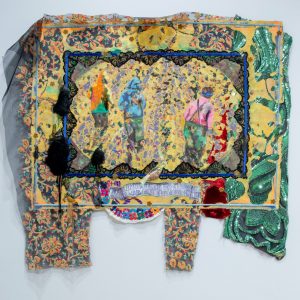Link About It: This Week’s Picks
The potential of seaweed farms, public art’s influence on safety, video games for depression and more from around the web

How Women in Bolivia Honor Their Indigenous Roots Through Skating
 In Cochabamba, Bolivia, an all-women skate crew called ImillaSkate uses skateboarding as a way to honor their roots, empower each other and stand against the persecution that Indigenous people have historically faced in the country. The women, who hail from Bolivia’s native Aymara and Quechua populations, skate in polleras—colorful, layered skirts traditionally worn in their culture. The unexpected attire harkens back to when Spanish colonial rule stole land from Indigenous communities, marginalizing and oppressing them to the point that many women abandoned their polleras for fear of discrimination. “By skating in polleras,” says Daniela Santiváñez, co-founder of ImillaSkate, “we want to show that girls and women can do anything, no matter how you look or how people see you.” Read more from Santiváñez—and view the vivid photographs of the crew from Brazilian photographer Luisa Dörr—at NPR.
In Cochabamba, Bolivia, an all-women skate crew called ImillaSkate uses skateboarding as a way to honor their roots, empower each other and stand against the persecution that Indigenous people have historically faced in the country. The women, who hail from Bolivia’s native Aymara and Quechua populations, skate in polleras—colorful, layered skirts traditionally worn in their culture. The unexpected attire harkens back to when Spanish colonial rule stole land from Indigenous communities, marginalizing and oppressing them to the point that many women abandoned their polleras for fear of discrimination. “By skating in polleras,” says Daniela Santiváñez, co-founder of ImillaSkate, “we want to show that girls and women can do anything, no matter how you look or how people see you.” Read more from Santiváñez—and view the vivid photographs of the crew from Brazilian photographer Luisa Dörr—at NPR.
Image courtesy of Luisa Dörr/NPR
New Study Reveals Public Art Decreases Traffic Accidents
 During the pandemic, the US saw an unprecedented 21% increase in pedestrian fatalities. As the country looks to update its federal traffic safety guidance to mitigate this, a new report entitled Asphalt Art Safety Study from Sam Schwartz Consulting and Bloomberg Philanthropies offers solutions. The study examines the impact that asphalt art—which includes intersection murals, crosswalk art and painted plazas and bridge underpasses—has on the street. It found a 50% drop in crashes involving pedestrians or cyclists and a 37% drop in crashes leading to injuries at intersections where art had been installed. In places where the study placed new projects, there was a 27% increase in the rate of drivers yielding to pedestrians. This data reveals that public art not only makes places more welcoming and inviting, but it also provides clearer lane and walkway designations and makes drivers more alert, decreasing traffic accidents. Learn more about this effective and low-cost solution at Bloomberg.
During the pandemic, the US saw an unprecedented 21% increase in pedestrian fatalities. As the country looks to update its federal traffic safety guidance to mitigate this, a new report entitled Asphalt Art Safety Study from Sam Schwartz Consulting and Bloomberg Philanthropies offers solutions. The study examines the impact that asphalt art—which includes intersection murals, crosswalk art and painted plazas and bridge underpasses—has on the street. It found a 50% drop in crashes involving pedestrians or cyclists and a 37% drop in crashes leading to injuries at intersections where art had been installed. In places where the study placed new projects, there was a 27% increase in the rate of drivers yielding to pedestrians. This data reveals that public art not only makes places more welcoming and inviting, but it also provides clearer lane and walkway designations and makes drivers more alert, decreasing traffic accidents. Learn more about this effective and low-cost solution at Bloomberg.
Image of Butterfly mural in Asheville, NC, by Sound Mind Creative, photo by Justin Mitchell
Latinx Project’s “Building Radical Soil” Explores Sustainability in Collective Art
 At NYU’s Latinx Project, Building Radical Soil is a group exhibition (on view now until 5 May) by nine artists who meditate on conservation methods throughout the Latin, African and Asian diaspora. Whether focusing on traditional or contemporary approaches to sustainability, the artists highlight how collective art-making acts as resistance against colonialism-induced climate change. Lina Puerta’s “Broccoli Crop Workers” is a tapestry that depicts figures representing America’s unrecognized agricultural labor and a quote from an NPR article that reads, “Improper exposure to pesticides harms 10 to 20 thousand agricultural workers every year. The people who harvest America’s food.” Another piece, Glendalys Medina’s print “Bank Statement (Levels),” recalls colonial trauma through a fictitious map that notes the permeable boundaries between Trinidad and Zambia. As a whole, the show “posits that resistance begins at the ground level, and that truly progressive traditions will outlast the neoliberal era,” writes Hyperallergic, where you can read more.
At NYU’s Latinx Project, Building Radical Soil is a group exhibition (on view now until 5 May) by nine artists who meditate on conservation methods throughout the Latin, African and Asian diaspora. Whether focusing on traditional or contemporary approaches to sustainability, the artists highlight how collective art-making acts as resistance against colonialism-induced climate change. Lina Puerta’s “Broccoli Crop Workers” is a tapestry that depicts figures representing America’s unrecognized agricultural labor and a quote from an NPR article that reads, “Improper exposure to pesticides harms 10 to 20 thousand agricultural workers every year. The people who harvest America’s food.” Another piece, Glendalys Medina’s print “Bank Statement (Levels),” recalls colonial trauma through a fictitious map that notes the permeable boundaries between Trinidad and Zambia. As a whole, the show “posits that resistance begins at the ground level, and that truly progressive traditions will outlast the neoliberal era,” writes Hyperallergic, where you can read more.
Image of Lina Puerta’s “Broccoli Crop Workers” (2017) by Tere Garcia, courtesy of Latinx Project
How a Video Game Helps Treat Depression and Mental Decline
 Sarah Shizuko Morimoto’s Neurogrow is a gardening video game designed to increase and improve neural circuitry. For those with geriatric depression or mental decline, the game crucially targets the brain to better respond to anti-depressants. It does so through a series of repetitive memorization and timing exercises—like watering a specific color flower with a corresponding watering can—to activate the brain. According to Pam Stevens, a 79-year-old woman who was told her cognitive decline was untreatable after a stroke, the game not only improved her mood and helped her become more social, but also made her more alert. Morimoto explains, “When you want a certain part of the brain activated, you use something similar to problems in a game. When someone solves a problem, a certain part of the brain lights up. So we started there and gamified those tasks.” Read more about Neurogrow and how video games can open doors to breakthrough treatments at NPR.
Sarah Shizuko Morimoto’s Neurogrow is a gardening video game designed to increase and improve neural circuitry. For those with geriatric depression or mental decline, the game crucially targets the brain to better respond to anti-depressants. It does so through a series of repetitive memorization and timing exercises—like watering a specific color flower with a corresponding watering can—to activate the brain. According to Pam Stevens, a 79-year-old woman who was told her cognitive decline was untreatable after a stroke, the game not only improved her mood and helped her become more social, but also made her more alert. Morimoto explains, “When you want a certain part of the brain activated, you use something similar to problems in a game. When someone solves a problem, a certain part of the brain lights up. So we started there and gamified those tasks.” Read more about Neurogrow and how video games can open doors to breakthrough treatments at NPR.
Image courtesy of Therapeutic Games and Apps Lab, University of Utah
The Immense Potential of Seaweed
 From food to fuel and products, seaweed provides more sustainable alternatives that benefit the planet. Dr Sophie Steinhagen of Sweden’s Tjärnö Marine Laboratory says that looking to the sea for resources is not just one recourse, but is the only way forward. “There is no other option,” she says. “Climate change is affecting most of our crop systems and we are in urgent need of new production. We cannot extend terrestrial farmland—so we need to go into the ocean.” There are currently seaweed plantations being established rapidly on the Atlantic and North Sea coasts in Europe, all harvesting “strand after strand of sea lettuce, translucent and emerald green” for alternatives for meat, soy and plastic. But most of the farms (90% of the market) are in Asia, “where entire bays in China, Indonesia and Japan are taken up by seaweed farms.” The remarkable marine plant already provides eco-friendly replacements for various products, and these farms continue to innovate—from extracting seaweed’s protein and polysaccharides to burning the remains as biofuel, and improving their crop production. Find out more at The Guardian.
From food to fuel and products, seaweed provides more sustainable alternatives that benefit the planet. Dr Sophie Steinhagen of Sweden’s Tjärnö Marine Laboratory says that looking to the sea for resources is not just one recourse, but is the only way forward. “There is no other option,” she says. “Climate change is affecting most of our crop systems and we are in urgent need of new production. We cannot extend terrestrial farmland—so we need to go into the ocean.” There are currently seaweed plantations being established rapidly on the Atlantic and North Sea coasts in Europe, all harvesting “strand after strand of sea lettuce, translucent and emerald green” for alternatives for meat, soy and plastic. But most of the farms (90% of the market) are in Asia, “where entire bays in China, Indonesia and Japan are taken up by seaweed farms.” The remarkable marine plant already provides eco-friendly replacements for various products, and these farms continue to innovate—from extracting seaweed’s protein and polysaccharides to burning the remains as biofuel, and improving their crop production. Find out more at The Guardian.
Image courtesy of The Guardian
Link About It is our filtered look at the web, shared daily in Link and on social media, and rounded up every Saturday morning. Hero image courtesy of Asphalt Art Initiative












